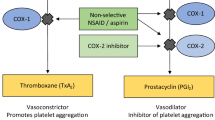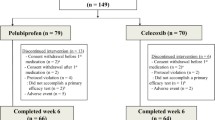Abstract
Purpose
Once daily doses of 100–400 mg lumiracoxib have been proposed to inhibit local prostaglandin synthesis longer than systemic prostaglandin synthesis due to local accumulation in inflamed, acidic tissue. Lower, less toxic doses, however, might still achieve the clinical goal and merit further contemplation.
Methods
In a randomized, double-blind, placebo-controlled, three-way cross-over study, 18 healthy men received, with an interval of 24 h, two oral doses of 50 mg lumiracoxib or for comparison, 90 mg etoricoxib, for which local tissue accumulation has not been claimed as therapeutic component. Systemic and local drug concentrations, assessed by means of subcutaneous in-vivo microdialysis, were related to COX-2 inhibiting effects, quantified as inhibition of prostaglandin ex-vivo production in whole blood as well as local tissue prostaglandin (PG) concentrations.
Results
Twenty-four hours after the first dose, only etoricoxib was detectable in plasma and inhibited PGE2 production. In contrast, after the second dose, systemic PGE2 concentrations were significantly reduced by both coxibs, indicating similar maximum systemic effects of the selected doses. The local COX-2 inhibition by etoricoxib was most pronounced for PGD2. To the contrary, no indication was given of local inhibition of PG production by lumiracoxib at the dose tested.
Conclusions
Doses of 50 mg lumiracoxib and 90 mg etoricoxib produced similar maximum inhibition of systemic COX-2 function whereas 50 mg lumiracoxib was ineffective in producing local COX-2 inhibition. At a 50 mg dosage, lumiracoxib does not provide peripheral effects that outlast its systemic actions in therapies of rheumatic diseases such as osteoarthritis.





Similar content being viewed by others

References
Farkouh ME, Kirshner H, Harrington RA, Ruland S, Verheugt FW, Schnitzer TJ, et al. Comparison of lumiracoxib with naproxen and ibuprofen in the Therapeutic Arthritis Research and Gastrointestinal Event Trial (TARGET), cardiovascular outcomes: randomised controlled trial. Lancet. 2004;364:675–84.
Schnitzer TJ, Burmester GR, Mysler E, Hochberg MC, Doherty M, Ehrsam E, et al. Comparison of lumiracoxib with naproxen and ibuprofen in the Therapeutic Arthritis Research and Gastrointestinal Event Trial (TARGET), reduction in ulcer complications: randomised controlled trial. Lancet. 2004;364:665–74.
Li Y, Slatter JG, Zhang Z, Doss GA, Braun MP, Stearns RA, et al. In vitro metabolic activation of lumiracoxib in rat and human liver preparations. Drug Metab Dispos. 2008;36:469–73.
Healthcare products Regulatory Agency. Press release: Prexige (lumiracoxib) licence has been suspended. http://www.mhra.gov.uk/NewsCentre/Pressreleases/CON2033078
H.C. Government of Canada. Withdrawal of market authorization for Prexige - Health Canada Advisory 2007–10–04. http://www.hc-sc.gc.ca/ahc-asc/media/advisories-avis/_2007/2007_141-eng.php.
Singer JB, Lewitzky S, Leroy E, Yang F, Zhao X, Klickstein L, et al. A genome-wide study identifies HLA alleles associated with lumiracoxib-related liver injury. Nat Genet. 2010;42:711–4.
Mangold JB, Gu H, Rodriguez LC, Bonner J, Dickson J, Rordorf C. Pharmacokinetics and metabolism of lumiracoxib in healthy male subjects. Drug Metab Dispos. 2004;32:566–71.
Scott G, Rordorf C, Reynolds C, Kalbag J, Looby M, Milosavljev S, et al. Pharmacokinetics of lumiracoxib in plasma and synovial fluid. Clin Pharmacokinet. 2004;43:467–78.
Geusens P, Lems W. Efficacy and tolerability of lumiracoxib, a highly selective cyclo-oxygenase-2 (COX2) inhibitor, in the management of pain and osteoarthritis. Ther Clin Risk Manag. 2008;4:337–44.
Schmidtko A, Burian M, Altis K, Hardt K, Angioni C, Schmidt R, et al. Pharmacological and histopathological characterization of a hyperalgesia model induced by freeze lesion. Pain. 2007;127:287–95.
Cayley A. On Latin Squares. Oxford Cambridge Dublin Messenger Math. 1890;19:135–137.
Patrignani P, Capone ML, Tacconelli S. Clinical pharmacology of etoricoxib: a novel selective COX2 inhibitor. Expert Opin Pharmacother. 2003;4:265–84.
Malmstrom K, Sapre A, Couglin H, Agrawal NGB, Mazenko RS, Fricke JR. Etoricoxib in acute pain associated with dental surgery: a randomized, double-blind, placebo- and active comparator-controlled dose-ranging study. Clin Ther. 2004;26:667–79.
Roy YM, Derry S, Moore RA. Single dose oral lumiracoxib for postoperative pain in adults. Cochrane Database Syst Rev. 2010;CD006865.
MSD. Arcoxia. Fachinformation (2009).
NovartisPharma. Prexige 100 mg. Fachinformation (2006).
Hinz B, Renner B, Cheremina O, Besz D, Zolk O, Brune K. Lumiracoxib inhibits cyclo-oxygenase 2 completely at the 50 mg dose: is liver toxicity avoidable by adequate dosing? Ann Rheum Dis. 2009;68:289–91.
Kilo S, Schmelz M, Koltzenburg M, Handwerker HO. Different patterns of hyperalgesia induced by experimental inflammation in human skin. Brain. 1994;117:385–96.
Kilo S, Forster C, Geisslinger G, Brune K, Handwerker HO. Inflammatory models of cutaneous hyperalgesia are sensitive to effects of ibuprofen in man. Pain. 1995;62:187–93.
Lewis T, Love WS. Vascular reactions of the skin to injury. Part III. - Some effects of freezing, of cooling and of warming. Heart. 1926;13:27–60.
Lötsch J, Angst MS. The mu-opioid agonist remifentanil attenuates hyperalgesia evoked by blunt and punctuated stimuli with different potency: a pharmacological evaluation of the freeze lesion in humans. Pain. 2003;102:151–61.
Chaurasia CS, Muller M, Bashaw ED, Benfeldt E, Bolinder J, Bullock R, et al. AAPS-FDA workshop white paper: microdialysis principles, application and regulatory perspectives. Pharm Res. 2007;24:1014–25.
Tegeder L, Zimmermann J, Meller ST, Geisslinger G. Release of algesic substances in human experimental muscle pain. Inflamm Res. 2002;51:393–402.
Tegeder I, Schmidtko A, Brautigam L, Kirschbaum A, Geisslinger G, Lötsch J. Tissue distribution of imipenem in critically ill patients. Clin Pharmacol Ther. 2002;71:325–33.
Bräutigam L, Nefflen JU, Geisslinger G. Determination of etoricoxib in human plasma by liquid chromatography-tandem mass spectrometry with electrospray ionisation. J Chromatogr B Analyt Technol Biomed Life Sci. 2003;788:309–15.
Patrignani P, Panara MR, Greco A, Fusco O, Natoli C, Iacobelli S, et al. Biochemical and pharmacological characterization of the cyclooxygenase activity of human blood prostaglandin endoperoxide synthases. J Pharmacol Exp Ther. 1994;271:1705–12.
Lötsch J, Darimont J, Skarke C, Zimmermann M, Hummel T, Geisslinger G. Effects of the opioid remifentanil on olfactory function in healthy volunteers. Life Sci. 2001;69:2279–85.
Tegeder I, Meier S, Burian M, Schmidt H, Geisslinger G, Lötsch J. Peripheral opioid analgesia in experimental human pain models. Brain. 2003;126:1092–102.
Skarke C, Reus M, Schmidt R, Grundei I, Schuss P, Geisslinger G, et al. The cyclooxygenase 2 genetic variant -765G>C does not modulate the effects of celecoxib on prostaglandin E2 production. Clin Pharmacol Ther. 2006;80:621–32.
Tacconelli S, Capone ML, Sciulli MG, Ricciotti E, Patrignani P. The biochemical selectivity of novel COX-2 inhibitors in whole blood assays of COX-isozyme activity. Curr Med Res Opin. 2002;18:503–11.
Esser R, Berry C, Du Z, Dawson J, Fox A, Fujimoto RA, et al. Preclinical pharmacology of lumiracoxib: a novel selective inhibitor of cyclooxygenase-2. Br J Pharmacol. 2005;144:538–50.
Croom KF, Siddiqui MA. Etoricoxib: a review of its use in the symptomatic treatment of osteoarthritis, rheumatoid arthritis, ankylosing spondylitis and acute gouty arthritis. Drugs. 2009;69:1513–32.
Ricciotti E, FitzGerald GA. Prostaglandins and inflammation. Arteriosclerosis, thrombosis, and vascular biology. 2011;31:986–1000.
Shimura C, Satoh T, Igawa K, Aritake K, Urade Y, Nakamura M, et al. Dendritic cells express hematopoietic prostaglandin D synthase and function as a source of prostaglandin D2 in the skin. Am J Pathol. 2010;176:227–37.
Hanson J, Gille A, Zwykiel S, Lukasova M, Clausen BE, Ahmed K, et al. Nicotinic acid- and monomethyl fumarate-induced flushing involves GPR109A expressed by keratinocytes and COX-2-dependent prostanoid formation in mice. J Clin Inv. 2010;120:2910–9.
Sood A, Arora R. Mechanisms of flushing due to niacin and abolition of these effects. J Clin Hypertens. 2009;11:685–9.
Burian M, Tegeder I, Seegel M, Geisslinger G. Peripheral and central antihyperalgesic effects of diclofenac in a model of human inflammatory pain. Clin Pharmacol Ther. 2003;74:113–20.
Zhang J, Ding EL, Song Y. Adverse effects of cyclooxygenase 2 inhibitors on renal and arrhythmia events: meta-analysis of randomized trials. JAMA : J Am Med Assoc. 2006;296:1619–32.
Bressan E, Tonussi CR. Antiinflammatory effects of etoricoxib alone and combined with NSAIDs in LPS-induced reactive arthritis. Inflamm Res. 2008;57:586–92.
DrugBank. www.drugbank.ca. (accessed in May 2013).
Moreira TS, de Sousa VP, Pierre MB. Influence of oleic acid on the rheology and in vitro release of lumiracoxib from poloxamer gels. Journal of pharmacy & pharmaceutical sciences: a publication of the Canadian Society for Pharmaceutical Sciences, Societe canadienne des sciences pharmaceutiques. 2010;13:286–302.
Okumu A, DiMaso M, Lobenberg R. Computer simulations using GastroPlus to justify a biowaiver for etoricoxib solid oral drug products. Eur J Pharm Biopharm : Off J Arbeitsgemeinschaft fur Pharm Verfahrenstechnik eV. 2009;72:91–8.
Brune K, Hinz B. Selective cyclooxygenase-2 inhibitors: similarities and differences. Scand J Rheumatol. 2004;33:1–6.
Bannwarth B, Berenbaum F. Clinical pharmacology of lumiracoxib, a second-generation cyclooxygenase 2 selective inhibitor. Expert Opin Investig Drugs. 2005;14:521–33.
Shiand S, Klotz U. Clinical use and pharmacological properties of selective COX-2 inhibitors. Eur J Clin Pharmacol. 2008;64:233–52.
Acknowledgments And Disclosures
Lisa Felden and Carmen Walter contributed equally. We thank Prof. Michael Parnham for manuscript language editing. A preliminary report on part of the results has been presented as a conference abstract (Naunyn Schmiedebergs Arch Pharmacol 2011(383), Suppl 1, page 75).
The authors have declared that no competing interests exist. This study was sponsored by the Deutsche Arthrose-Hilfe, Saarlouis, Germany. Additional support was also obtained for the analytical procedures by Deutsche Forschungsgemeinschaft, SFB 1039/Z1 (GG). The funders had no role in study design, data collection and analysis, decision to publish, or preparation of the manuscript.
Author information
Authors and Affiliations
Corresponding author
Electronic supplementary material
Below is the link to the electronic supplementary material.
ESM 1
(DOCX 65 kb)
Rights and permissions
About this article
Cite this article
Felden, L., Walter, C., Angioni, C. et al. Similar Maximum Systemic but not Local Cyclooxygenase-2 Inhibition by 50 mg Lumiracoxib and 90 mg Etoricoxib: A Randomized Controlled Trial in Healthy Subjects. Pharm Res 31, 1813–1822 (2014). https://doi.org/10.1007/s11095-013-1285-z
Received:
Accepted:
Published:
Issue Date:
DOI: https://doi.org/10.1007/s11095-013-1285-z



